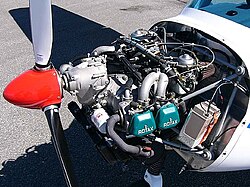Aircraft
Rotax is one of the world's principal suppliers of aircraft engines for ultralight aircraft, light aircraft and unmanned aerial vehicles. [2] Between 1985 and 1995, 60,000 Rotax engines were sold for aircraft propulsion. [2] In the light aircraft class, in 1998 Rotax outsold all other aero engine manufacturers combined. [4] Their four-stroke engines powered most U.S.-certified light sport aircraft when they first appeared around 2004. [5] Over two decades later, Rotax engines remain the most popular line of engines for light sport and ultralight aircraft, [6] [7] and the second-most-popular (after Lycoming Engines) for U.S. Experimental / Amateur-Built (E/A-B) aircraft. [8]
Two-stroke aircraft engines
Rotax air-cooled, two-stroke engines began appearing on ultralight aircraft in the early 1980s, with a pair of single-cylinder, 7.1 kW (9.5 hp) Rotax 185s [11] [12] powering the single-seat Lazair ultralight by 1982. [12] Soon, the 19 kW (26 hp), single-cylinder Rotax 277 [11] became the most widely used engine powering U.S. ultralight aircraft (and remains, for many, the only Rotax engine they can use to adequately power the aircraft and still remain within the FAA-mandated weight limits for ultralight aircraft which can be operated without a pilot's license). [13]
Two-stroke Rotax model numbers approximated the engine's displacement (in cubic centimeters), and the first two digits (from the 277, on) are very roughly similar to the engine's horsepower (e.g.: The Rotax 447 engine displaces 437 cc, and is rated at 30 kW (40 hp)). [11]
Subsequent evolutions of the early designs included the two-cylinder, two-stroke Rotax 377, Rotax 447, and Rotax 503, all in production by 1985 [11] (the last of these, the 503, was discontinued in 2010-2011, by then the most popular engine it its class, and still widely used as of 2023). [14] Later two-stroke designs included the Rotax 532 (circa 1984) and Rotax 582, both of which augmented the air-cooling with liquid-cooled cylinder heads. [11]
Most Rotax two-stroke engines were rated, recommended, or reported with a TBO (time between overhauls) of about 150-300 hours (compared to 1200-2000 hours for government-certified, conventional, four-stroke, light aircraft engines), though later models improved upon that some. [15]
Four-stroke aircraft engines
Moving towards more demanding aircraft applications, Rotax, by 1989, developed a four-stroke, four-cylinder, engine: the Rotax 912, with versions eventually ranging from 60 to 75 kW (80 to 100 hp), followed by a turbocharged 115 horsepower Rotax 914. [5]
Rotax four-stroke engines differ from conventional four-stroke aircraft engines by their unusually small displacement for the amount of power -- compensated for by higher than normal rotational speed (over 5,000 rpm). To reduce propeller-shaft speeds to normal aircraft propeller rotational speeds, (around 2300-2400 rpm) the engines use a reduction gearbox. [5] They are also designed to accept motor spirit, with up to 10% ethanol content. [16] [17]
These engines were initially given a 600-hour Time Before Overhaul (TBO), less than traditional light aircraft engines. [5] [18] [19] But operational experience and modifications to address specific reliability issues over time gradually extended the TBO to 2,000 hours. [5] [18] [19] [17] An independent 2022 statistical study of U.S. government accident data found that the Rotax 912 family had the lowest rate of failure of the six most common lines of engines used in registered Experimental/Amateur-Built (E/A-B) aircraft. [8]
By 2014, Rotax had produced and sold 50,000 of 912/914 four-stroke engines. [5] Later models increased power, with several variants of the 912 family, and a new 100 kW (135 hp) Rotax 915 iS. [5] [20]
The Rotax four-stroke aircraft engine line immediately dominated the emerging category of U.S.-certified "Light Sport Aircraft" (LSAs), powering most of them. [6] [14] One general aviation industry media reporter found that 70-80% of the 66,000 aircraft he'd identified, worldwide, used Rotax four-stroke engines. [14] The 912/914/915 series also powers larger certified aircraft, including the Diamond Katana, and the twin-engined Tecnam P2006T and Leza/Lockwood Aircam. [6]
Motorcycles
The Can-Am division of Bombardier Inc. developed a line of motorcycles starting in 1971, powered by Rotax engines. The Can-Am motorcycle operation was outsourced to Armstrong-CCM Motorcycles in 1983, with production ending in 1987.
Can-Am resumed motorcycle production with a series of on-road three-wheel motorcycles, starting with the Spyder, using Rotax engines. As of 2020, there are three models: the Ryker uses the 2-cylinder 600 ACE and 3-cylinder 900 ACE, the Spyder F3 and the Spyder RT use the 3-cylinder 1330 ACE. 1000 V-twin 5sp. [21]
In the motorcycle world Rotax are particularly known for their single-cylinder engines of comparatively small to medium displacement. Several major motorbike manufacturers, who are otherwise renowned for their proprietary but bigger engines, use Rotax engines in their smaller models.
As an example of larger displacements, Rotax developed a 798 cc parallel twin engine with and for BMW, which was built from 2006 to 2020.
Brands using Rotax engines include:
- Aprilia Pegaso, Aprilia RSV Mille, Aprilia RSV 1000 R, Aprilia Tuono the Falco and Futura.
- ATK 250, 350, 406, 560, 604, 605
- BMW F650, BMW F800S, BMW F800ST, BMW F800GT, BMW F800R, BMW F800GS
- Buell 1125, 604, 636 ccm
- Harley-Davidson MT500
- KTM
- Matchless
- MV Agusta
- MZ
- Classic Legends BSA Gold Star 650


